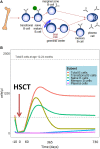B Cell Reconstitution and Influencing Factors After Hematopoietic Stem Cell Transplantation in Children
- PMID: 31031769
- PMCID: PMC6473193
- DOI: 10.3389/fimmu.2019.00782
B Cell Reconstitution and Influencing Factors After Hematopoietic Stem Cell Transplantation in Children
Abstract
B cell reconstitution after hematopoietic stem cell transplantation (HSCT) is variable and influenced by different patient, donor, and treatment related factors. In this review we describe B cell reconstitution after pediatric allogeneic HST, including the kinetics of reconstitution of the different B cell subsets and the development of the B cell repertoire, and discuss the influencing factors. Observational studies show important roles for stem cell source, conditioning regimen, and graft vs. host disease in B cell reconstitution. In addition, B cell recovery can play an important role in post-transplant infections and vaccine responses to encapsulated bacteria, such as pneumococcus. A substantial number of patients experience impaired B cell function and/or dependency on Ig substitution after allogeneic HSCT. The underlying mechanisms are largely unresolved. The integrated aspects of B cell recovery after HSCT, especially BCR repertoire reconstitution, are awaiting further investigation using modern techniques in order to gain more insight into B cell reconstitution and to develop strategies to improve humoral immunity after allogeneic HSCT.
Keywords: B lymphocyte; allogeneic; hematopoietic stem cell transplantation; immune reconstitution; pediatric; subsets.
Figures

References
-
- Passweg JR, Baldomero H, Bader P, Bonini C, Duarte RF, Dufour C, et al. . Use of haploidentical stem cell transplantation continues to increase: the 2015 European Society for Blood and Marrow Transplant activity survey report. Bone Marrow Transplant. (2017) 52:811–7. 10.1038/bmt.2017.34 - DOI - PMC - PubMed
-
- Antin JH, Emerson SG, Martin P, Gadol N, Ault KA. Leu-1+ (CD5+) B cells. A major lymphoid subpopulation in human fetal spleen: phenotypic and functional studies. J Immunol. (1986) 136:505–10. - PubMed
Publication types
MeSH terms
Substances
LinkOut - more resources
Full Text Sources

